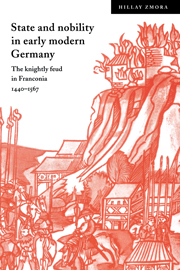Book contents
- Frontmatter
- Contents
- List of figures
- List of tables
- Preface
- List of abbreviations
- 1 The problem of the feud
- 2 The politics of violence: feuding in late medieval Franconia
- 3 The Franconian nobility
- 4 Prosopography of feuding noblemen
- 5 State, nobility, and lordship: the feud interpreted
- 6 The decline of the feud
- A note on Appendixes
- Appendix A Creditors and guarantors of the margraves of Brandenburg
- Appendix B Sample of intermarriages among the noble élite
- Appendix C Individual parameters of feuders (Sample-I)
- Appendix D Family parameters of feuders (Sample-I)
- Appendix E Individual parameters of feuders (Sample-II)
- Appendix F Family parameters of feuders (Sample-II)
- Sources of information for Appendix A
- Sources of Information for Appendixes C and D
- Sources of Information for Appendixes E and F
- Selected bibliography
- Index
- CAMBRIDGE STUDIES IN EARLY MODERN HISTORY
Preface
Published online by Cambridge University Press: 29 October 2009
- Frontmatter
- Contents
- List of figures
- List of tables
- Preface
- List of abbreviations
- 1 The problem of the feud
- 2 The politics of violence: feuding in late medieval Franconia
- 3 The Franconian nobility
- 4 Prosopography of feuding noblemen
- 5 State, nobility, and lordship: the feud interpreted
- 6 The decline of the feud
- A note on Appendixes
- Appendix A Creditors and guarantors of the margraves of Brandenburg
- Appendix B Sample of intermarriages among the noble élite
- Appendix C Individual parameters of feuders (Sample-I)
- Appendix D Family parameters of feuders (Sample-I)
- Appendix E Individual parameters of feuders (Sample-II)
- Appendix F Family parameters of feuders (Sample-II)
- Sources of information for Appendix A
- Sources of Information for Appendixes C and D
- Sources of Information for Appendixes E and F
- Selected bibliography
- Index
- CAMBRIDGE STUDIES IN EARLY MODERN HISTORY
Summary
Late medieval and early modern Germans often accused noblemen of using the feud as a legal mantle with which to cloak their real purpose: banditry. Modern historians, believing that the nobility of this period was in economic crisis, have not taken exception to this view. A somewhat similar charge of ulterior motives can be made against the book that follows. For the feud, albeit forming its focus, serves as a ‘pretext’ for exploring other, larger themes. However interesting a subject the knightly feud may be in its own right, its real value lies elsewhere: in what it reveals about polity and society; more specifically, about state and nobility and the relationship between them. Together, these two formations constitute the core of the book. Indeed, the essence of the interpretation it offers is that the feud both resulted from, and helped to shape, an interplay between princely state building and social stratification among the aristocracy. An analysis of the feud thus illuminates both processes as few other phenomena can.
This interplay was probably already at work before 1440. But it is then that the links become apparent in the extant documentation. The year 1440 is therefore the temporal point of departure of the present study. However, the choice of this date is not entirely arbitrary: the years around 1440 saw a significant upsurge in the intensity of the territorial conflicts between the Franconian princes. And it was mainly for this reason that the role which noblemen's feuds played in these struggles became both more important and more transparent. Feuds continued unabated until the second half of the sixteenth century.
- Type
- Chapter
- Information
- State and Nobility in Early Modern GermanyThe Knightly Feud in Franconia, 1440–1567, pp. xi - xiiPublisher: Cambridge University PressPrint publication year: 1998

